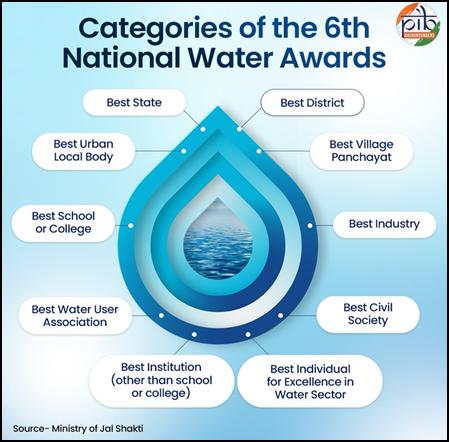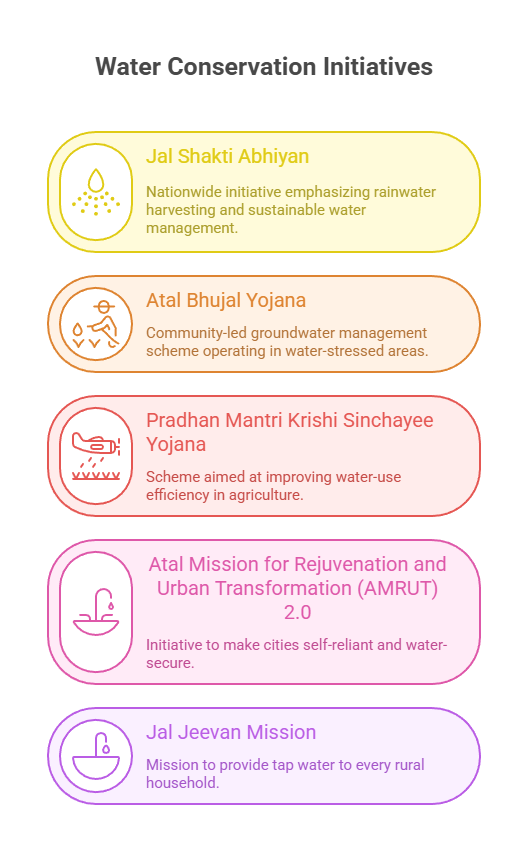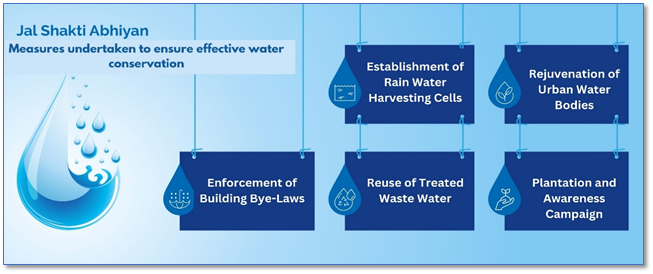Governance
Efficient Water Management in Agriculture
- 20 Nov 2025
- 10 min read
For Prelims: National Water Awards, Jal Sanchay Jan Bhagidari (JSJB) Awards, Jal Sanchay Jan Bhagidari initiative, Artificial Intelligence, Internet of Things
For Mains: Groundwater depletion, salinity, and irrigation inefficiencies in India, Whole-of-Government and Whole-of-Society approach in water management
Why in News?
At the 6th National Water Awards, President Droupadi Murmu urged urgent innovation in agricultural water use, reminding the country that water is a sacred and finite national resource.
What are the National Water Awards?
- About: The National Water Awards launched in 2018, under the Department of Water Resources, River Development and Ganga Rejuvenation, Ministry of Jal Shakti.
- The awards were conceived as a platform to honour individuals, organisations, and states that demonstrate innovation, leadership, and dedication in the field of water conservation.
- Purpose: To support the national vision of “Jal Samridh Bharat” - a water-secure and water-enriched India.
- They promote water-use efficiency, recycling and reuse, and broader public awareness.
- The awards aim to strengthen people’s participation, build capacity and support the long-term sustainability of groundwater resources.
- 6th National Water Awards: The 6th National Water Awards 2024 selected 46 winners, including joint awardees, across 10 categories.
- Maharashtra topped the Best State category, followed by Gujarat and Haryana.
What is the Need for Efficient Water Use in Agriculture?
- Mismatch Between Irrigation and Cropping Cycles: Large irrigation projects often take years to complete and miss peak sowing periods, reducing their usefulness.
- Canal repairs and desilting often finish after the monsoon, reducing their usefulness for the kharif season, and ageing canal networks lose up to 40% of water due to seepage, leakage, theft and poor maintenance.
- Policies promoting paddy and sugarcane have increased pressure on stressed aquifers, while some states providing free electricity for agriculture has encouraged excessive borewell pumping, worsening groundwater depletion.
- The lack of integration of traditional water harvesting structures weakens groundwater recharge and increases dependence on pumping.
- Minimal Use of Real-Time Data and Technology: Most irrigation decisions are made without using weather forecasts, soil moisture data or crop water requirement models.
- Only a few states, such as Andhra Pradesh and Karnataka, have begun applying remote sensing or crop analytics.
- Limited Adoption of Micro-Irrigation: Drip and sprinkler systems cover only about 12% of India’s irrigated area.
- Small farmers struggle with high installation costs, inconsistent electricity supply and limited technical support, slowing the shift toward efficient water use.
- Waterlogging and Soil Salinity: Poor drainage planning has placed nearly 13 million hectares of irrigated land at risk of waterlogging.
- These conditions sharply reduce crop yields and damage soil health.
- Groundwater Extraction and Contamination: India extracts about 25% of the world’s groundwater. Since groundwater supports 62% of irrigation and a major share of rural and urban water needs, overexploited blocks with declining recharge demand urgent innovation.
- Excessive use of fertilisers and pesticides has led to nitrate contamination in 56% of districts. In coastal belts, over-extraction has caused salinity intrusion, reducing agricultural productivity and harming ecosystems.
- Climate Change and Erratic Monsoons: Since the monsoon provides nearly 60% of groundwater recharge, unpredictable rainfall patterns directly affect irrigation security.
- In 2023, a 5.6% rainfall shortfall across more than 200 districts pushed states like Tamil Nadu to over-extract deep aquifers.
What Innovative Measures Can Support India’s Long-Term Water Security?
- AI-Driven Piped Irrigation Systems: Building on Microsoft’s Project FarmVibes, integrating piped irrigation with Artificial Intelligence, Internet of Things (IoT) sensors and satellite data enables precise, need-based water delivery to crops.
- This reduces transmission losses, prevents over-pumping and ensures equitable distribution, especially to tail-end farmers directly addressing India’s water loss and chronic groundwater stress.
- Digital Twin Models for Irrigation Command Areas: Creating virtual, real-time replicas of irrigation networks helps track canal releases, soil moisture, crop stress and groundwater levels.
- These models support dynamic water allocation and minimise mismatch between irrigation scheduling and crop cycles.
- Village-Level Water Budgeting: Preparing annual water budgets for villages and aligning cropping patterns with actual water availability reduces over-extraction and prevents cultivation of high-water crops in stressed regions.
- This approach strengthens local accountability and directly addresses aquifer depletion.
- Aquifer Recharge Using Modern and Traditional Systems: Combining recharge shafts, percolation tanks and treated wastewater with restored traditional structures like baolis and johads can rebuild depleted aquifers.
- This hybrid recharge strategy is essential for states that have crossed safe extraction limits.
- Smart Micro-Irrigation: Solar-powered drip and sprinkler systems linked to automated valves allow farmers to irrigate based on soil moisture and weather forecasts.
- This ensures major water savings, lowers energy use and reduces dependence on erratic electricity supplies.
Conclusion
India’s water future depends on how wisely and efficiently every drop is used. By combining technology, community leadership and sustainable farming practices, the country can rebuild its fragile water systems. With timely innovation and collective effort, long-term water security can shift from a looming challenge to an achievable reality.
|
Drishti Mains Question: Q. Examine the need for innovation in agricultural water use in the context of India’s groundwater depletion. |
Frequently Asked Questions (FAQs)
1. What is the purpose of the National Water Awards?
They recognise innovation and leadership in water conservation, supporting the vision of Jal Samridh Bharat and encouraging efficient water use, recharge and community participation.
2. What isJal Sanchay Jan Bhagidari initiative?
It promotes large-scale community-led groundwater recharge through the 3Cs model—Community, CSR and Cost—resulting in 35 lakh recharge structures, far exceeding targets.
3. Why does India need innovation in agricultural water use?
Because traditional irrigation causes 40% water loss, groundwater is over-extracted, micro-irrigation adoption is low and climate change is making monsoons unpredictable.
4. What targets were set under the JSJB initiative?
Districts were tasked with 10,000 recharge structures (3,000 in NE/Hilly areas), Municipal Corporations with 10,000, and Urban Local Bodies with at least 2,000 structures.
UPSC Civil Services Examination, Previous Year Questions (PYQs)
Prelims
Q1. With reference to ‘Water Credit’, consider the following statements: (2021)
- It puts microfinance tools to work in the water and sanitation sector.
- It is a global initiative launched under the aegis of the World Health Organization and the World Bank.
- It aims to enable the poor people to meet their water needs without depending on subsidies.
Which of the statements given above are correct?
(a) 1 and 2 only
(b) 2 and 3 only
(c) 1 and 3 only
(d) 1, 2 and 3
Ans: (c)
Q2. What are the benefits of implementing the ‘Integrated Watershed Development Programme’? (2014)
- Prevention of soil runoff
- Linking the country’s perennial rivers with seasonal rivers
- Rainwater harvesting and recharge of groundwater table
- Regeneration of natural vegetation
Select the correct answer using the code given below:
(a) 1 and 2 only
(b) 2, 3 and 4 only
(c) 1, 3 and 4 only
(d) 1, 2, 3 and 4
Ans: (c)
Mains
Q.1 What are the salient features of the Jal Shakti Abhiyan launched by the Government of India for water conservation and water security? (2020)
Q.2 Suggest measures to improve water storage and irrigation system to make its judicious use under the depleting scenario. (2020)










